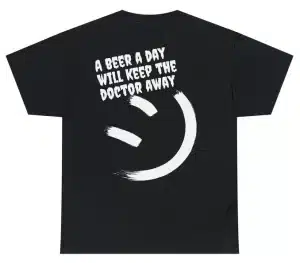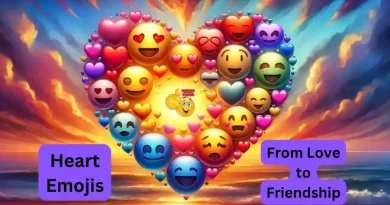The Eyes Emoji 👀: Meanings And Variations
The huge variety of emojis can contain concealed implications and subtle hints that can totally alter the message’s feeling.
You may have used the eyes emoji without giving much thought to its potential implications. But trust me, understanding these tiny symbols can elevate your digital communication game immensely.
In this journey through How To Use The Eyes Emoji and Its Variations, we’ll dive into the fascinating universe behind those two little dots on your screen. So buckle up!
| Emoji | Name | Meaning and Interpretation |
|---|---|---|
| 👀 | Eyes | Curiosity, interest, attention, observing |
| 👁️ | Eye | Awareness, perception, vigilance |
| 👁️🗨️ | Eye in Speech Bubble | Observation, potential discussion |
| 😳 | Flushed Face | Surprise, embarrassment |
| 😵 | Dizzy Face | Overwhelm, confusion |
| 😎 | Smiling Face with Sunglasses | Confidence, nonchalance |
| 🤩 | Star-Struck | Impressed, excited, infatuated |
| 😍 | Heart Eyes | Love, admiration, fondness |
| 👅 | Tongue Out and Winking Eye | Playfulness, humor, flirtation |
| 🙄 | Face with Rolling Eyes | Exasperation, annoyance, disbelief |
| 😔 | Pensive Face | Sadness, thoughtfulness, introspection |
Click Here To Get This Shirt and More on Our Etsy Store
Table of Contents:
- The Evolution and Popularity of Emoji
- The Science Behind Emoji Design
- Emotional Lexicons and Emoji
- The Power of Nonverbal Communication via Emoji
- Understanding Emoji’s Social Influence
- Cultural Diversity in Emoji Use
- Future Directions for Research on Emojis
- FAQs in Relation to How to Use the Eyes Emoji
- Conclusion
The Ultimate Guide to Eye Emojis 👁️
Ever stopped to think about how much emotion a pair of eyes—or even just one eye—can convey? Well, you’re about to find out! 🌟😍 Let’s get into the nitty-gritty of eye emojis and really understand the vibe each one brings to the table. 📝
1. The Classic Eyes Emoji 👀
How to Use: This is your go-to for showing interest or curiosity. It’s like an “I’m watching” or “Tell me more.”
Example: “So, you went on a date last night? 👀”
2. Raised Eyebrow Emoji 🤨
How to Use: Perfect when you’re skeptical or questioning something. It’s like saying, “Really?”
Example: “You finished all your chores? 🤨”
3. Unamused Face Emoji 😒
How to Use: This one screams “not impressed” or “I don’t believe you.”
Example: “Another lame joke, huh? 😒”
4. Heart Eyes Emoji 😍
How to Use: When you’re absolutely in love with what you’re seeing or hearing.
Example: “This puppy is adorable! 😍”
5. Eye Roll Emoji 🙄
How to Use: For those moments when you just can’t even. Use it when you’re feeling sarcastic or annoyed.
Example: “Sure, I’d love to work late. 🙄”
6. Winking Eye with Tongue Emoji 😜
How to Use: This is all about playful vibes. Use it when you’re teasing or being cheeky.
Example: “Beat you at the game again! 😜”
7. Wink Emoji 😉
How to Use: The classic way to hint that you’re joking or flirting. It’s subtle but effective.
Example: “See you at the party, if you can handle it 😉”
8. Flushed Face Emoji😳
How to Use: For those OMG moments when you’re surprised, shocked, or embarrassed.
Example: “I can’t believe I said that 😳”
9. Pleading Eyes Emoji🥺
How to Use: When you’re begging or really want something. It’s the ultimate puppy-dog eyes in emoji form.
Example: “Can we please go to the beach? 🥺”
10. Sunglasses Emoji😎
How to Use: For those times when you’re feeling super cool or confident.
Example: “Aced the test, no big deal 😎”
And there you have it, folks! A complete rundown of eye emojis to make sure you’re literally seeing eye to eye with whoever you’re texting. 🤓
Stay emoji-savvy, peeps! 😘✌️
Liven Up Your Texting Game With the Eyes Emoji 👀
Ah, the Eyes emoji—a symbol loaded with curiosity, interest, and sometimes a pinch of drama. It’s like the Swiss Army knife of emojis; it’s got a function for nearly every convo you’re in. 📱
Why the Eyes Emoji is Everything
So why is the Eyes emoji such a big deal? For starters, it’s super versatile. You can drop it when you’re curious, excited, or even a little skeptical. Plus, it’s an excellent way to show you’re paying attention. Like, “I see you, and I’m here for it.” 🙌
Ready to dive in? Here we go!
25 Ways to Elevate Your Text Game With the Classic Eyes Emoji 👀
| Eyes Emoji Combo | Context | Text Example |
|---|---|---|
| 👀💬 | Curious chat | What’s the news? 👀💬 |
| 👀🍕 | Pizza love | Pizza tonight? 👀🍕 |
| 👀🎁 | Gift excitement | I wonder what’s inside 👀🎁 |
| 👀📚 | Book interest | This book looks good 👀📚 |
| 👀🌈 | Pride awareness | Happy Pride! 👀🌈 |
| 👀🛍️ | Shopping spree | Shopping spree, anyone? 👀🛍️ |
| 👀🎵 | Music fan | This song is great 👀🎵 |
| 👀🍿 | Movie snacks | Movie and popcorn 👀🍿 |
| 👀🍷 | Wine lover | Wine night? 👀🍷 |
| 👀⚽ | Soccer fan | Watching the game 👀⚽ |
| 👀👠 | Fashionista | Those heels! 👀👠 |
| 👀🎥 | Movie buff | Movie night? 👀🎥 |
| 👀🏋️ | Workout focus | Focus on the workout 👀🏋️ |
| 👀☕ | Coffee obsession | Need that coffee 👀☕ |
| 👀🌸 | Spring vibes | Spring is here 👀🌸 |
| 👀🛒 | Grocery shopping | What’s on the shopping list? 👀🛒 |
| 👀🏝️ | Beach daydream | Dreaming of the beach 👀🏝️ |
| 👀🌮 | Taco love | Tacos, please! 👀🌮 |
| 👀❤️🔥 | Romantic tension | Sparks flying 👀❤️🔥 |
| 👀👀 | Double take | Did I see that right? 👀👀 |
| 👀😜 | Playful mood | Feeling cheeky 👀😜 |
| 👀🍣 | Sushi craving | Sushi date? 👀🍣 |
| 👀🌠 | Stargazing | Let’s go stargazing 👀🌠 |
| 👀👗 | Dress admiration | That dress is stunning 👀👗 |
| 👀🐶 | Pet curiosity | What’s the dog doing? 👀🐶 |
So, don’t sleep on the Eyes emoji, okay? It’s got layers, and it can add that extra zing to your texts. Go ahead, try it out and watch your texting game go from meh to wow! 🤩
Flirty Eyes Emojis to Elevate Your Text Game 👀💖
Heyyy, all you text-savvy peeps! You ready to turn the heat up in your messages? If you’re like me, emojis are your love language, and today, we’re diving deep into the flirty world of eye emojis. 😍👀
Now, we’ve all been there, right? You’re texting someone cute, and you’re at a loss for words. That’s where our little eye emojis come into play. They’re the ultimate wingman in pixel form, helping you send those wink-wink, nudge-nudge vibes without saying too much—or too little.
You might be wondering, “Can emojis really set the mood?” Oh, you bet they can! They’re like the spicy salsa to your tortilla chip of love, adding that extra kick to make everything more exciting. And let’s be real, who doesn’t want to keep their crush guessing?
So, whether you’re a seasoned flirter or you’re just dipping your toes in the dating pool, get ready to kick your text game up a notch. Scroll down for 20 eye-popping (get it? 😜) examples that’ll make your messages impossible to ignore.
Ready? Set. Flirt! 🔥😘✌️
- 👀❤️ – Eyeing Love: “What are you up to tonight? 👀❤️”
- 👀😘 – Sending a Kiss: “See you later 👀😘”
- 😍👀 – Love-Struck: “You look amazing 😍👀”
- 🤨😏 – Skeptical but Interested: “Really? You like me? 🤨😏”
- 😒👀 – Not Impressed but Intrigued: “You think you can win me over? 😒👀”
- 🙄😜 – Rolling Eyes Playfully: “Oh, you’re funny 🙄😜”
- 😜👀 – Teasing You: “Catch me if you can 😜👀”
- 😉👀 – Winking at You: “How about a date? 😉👀”
- 😳😘 – Embarrassed but Into You: “Did I really just say that? 😳😘”
- 🥺👀 – Pleading for Your Love: “Can we be more than friends? 🥺👀”
- 😎😘 – Cool and Flirty: “Meet you at the club 😎😘”
- 👀🌹 – Eyeing a Romantic Gesture: “How about a date? 👀🌹”
- 🤨❤️ – Skeptically in Love: “So, you love me? 🤨❤️”
- 😒😘 – Annoyed but Flirty: “Trying to win me over? 😒😘”
- 🙄❤️ – Rolling Eyes but Loving: “Yeah, you wish 🙄❤️”
- 😜❤️ – Teasing Love: “Teasing you is fun 😜❤️”
- 😉😍 – Winking Love: “How about a kiss? 😉😍”
- 😳❤️ – Shocked by Love: “I can’t believe you said that 😳❤️”
- 🥺😘 – Pleading for a Kiss: “Kiss me please 🥺😘”
- 😎❤️ – Too Cool for Love: “Love you, but I’m cooler 😎❤️”
Get out there and start adding some sizzle to your texts! 🔥😘✌️
The Evolution and Popularity of Emoji
Have you ever taken a moment to contemplate the incredible popularity of emojis in our digital conversations? The rise in their usage has been so significant that as of March 2023, there were an astounding 3,019 emojis available in Unicode. If we take Instagram for instance, nearly half the text messages contain at least one emoji. In fact, back in 2015 Oxford English Dictionary named ’emoji’ as its word of the year.
The Unicode Consortium and Emoji Approval
If you’re wondering who’s behind these colorful symbols that help us express ourselves better digitally – it’s none other than Unicode Consortium. This international organization is responsible for standardizing character sets used across computing systems worldwide which includes approving new emoji designs too.
A great example would be when after strong advocacy from people living with disabilities demanding more representation within this medium led to the introduction of the guide dog emoji.
The Science Behind Emoji Design
Beyond just aesthetics lies deep science involved while crafting each emoticon. Automatically generated emoji vectors are employed, ensuring universally recognized symbols can be created efficiently without compromising consistency across different devices or operating systems.
- Facial Emojis: These types outperform non-facial ones significantly due to their ability to accurately present facial expressions, thereby conveying emotions effectively online.
- User Preferences: Investigating user preferences could provide valuable insights into designing future emojis.
When it comes to digital communication, emojis are the unsung heroes. They’re more than just cute little symbols – they have a science behind their design and use.
Automatically generated emoji vectors based on specific criteria play an integral role in creating these universally recognized symbols. It’s not a straightforward task of sketching a smiley face or heart; it involves more than that.
Facial vs Non-Facial Emojis: The Winner is Clear
Surprising to some, facial emoji come out on top when it comes to accurately expressing emotions. This makes sense if you think about how we communicate in person – our faces often say so much more than words ever could.
In fact, research has shown users’ actual facial expressions can differ from the emoticons they choose due to cultural nuances or personal preferences. No matter the reasons behind emoji selection, facial emojis remain a popular choice due to their ability to precisely convey human-like emotions. Facial emojis dominate because of their ability for presenting human-like expressions with precision.
Depicting Complex Emotions through Emoji
We’ve all been there – trying desperately to express complex feelings via text messages only for them to get lost without proper emotional cues like tone and body language.
That’s where assigned multi-dimensional emotional vectors come in handy in designing effective engaging emojis which depict users’ real emotions.
These emotionally charged icons go beyond mere aesthetics by capturing intricate layers of human sentiments ranging from joyous highs to sorrowful lows, thereby making textual conversations feel a bit less robotic and a lot more authentic.
The art of depicting such nuanced emotions lies at the intersection of creativity, technology, and understanding human behavior patterns, thus paving the way towards developing richer and deeper forms of digital communication.
Sentiment Lexicon Approach Explained
A crucial part of constructing these expressive icons involves the sentiment lexicon approach, focusing primarily on matching suitable tags corresponding automatically.
This technique aids tasks like word sense disambiguation, determining the meaning behind certain words, which depends largely upon context clues provided by accompanying visuals, namely emojis.
By combining insights gained from analyzing inherent sentiments of each word, developers are able to create visually appealing yet emotionally accurate representations of various moods and states of mind, enhancing the overall quality of online interactions significantly while also bridging the gap between verbal and nonverbal modes of expression in the digitally connected world today.
Key Takeaway:
Emojis, the unsung heroes of digital communication, are designed with scientific precision. Facial emojis reign supreme due to their human-like expressions. Emotionally charged icons depict complex feelings, making text conversations more authentic. The sentiment lexicon approach helps create visually appealing yet emotionally accurate representations for improved online interactions.
Emotional Lexicons and Emoji
In the realm of digital communication, emoji dictionaries are developed automatically to cater to a diverse range of emotional needs. These lexicons serve as critical tools for interpreting an emoji’s social influence and determining whether it represents positive or negative emotions.
The creation process involves building what we call ’emoji emotional lexicons’. Essentially, these databases pair various emojis with their corresponding sentiments. This matching system allows us to decode the emotion conveyed through each emoji more accurately.
Sentiment Lexicon Approach
This approach is all about linking textual expressions with visual representations – our beloved emojis. It aims at enhancing communication effectiveness while also assisting in tasks like word sense disambiguation task.
To put this into perspective, consider how specific sentiment scores or ‘tags’ are assigned to each emoji based on its common interpretation within digital conversations. For example, might be tagged as ‘happy’, whereas could be labeled as ‘sad’.
Interestingly enough, businesses have found significant value in using emotive symbols that align well with their messages. Studies suggest that such strategies can significantly increase click-through rates compared to traditional text-only communications.
Negative Emotions vs Positive Emotions: A Balancing Act In The World Of Emoji Representation
A key aspect when constructing automatic dictionaries is understanding how emojis representing negative emotions differ from those depicting positive ones. Negative emotion-related emojis often carry heavier weightage as they directly impact user experience during interactions . Misinterpretation here can lead to misunderstanding, making accurate representation vital. On the other hand, positive-emotion-based emojis tend to foster increased interaction rates because they elicit joyous responses from recipients.
The Power of Nonverbal Communication via Emoji
Emojis, those tiny digital symbols we sprinkle throughout our online conversations, have revolutionized the way we express ourselves in this increasingly virtual world. They’ve transformed from mere decorative elements into a form of non-verbal communication that often surpasses traditional text-based interactions.
This powerful capability is particularly evident when there’s a discrepancy between what people feel and how they choose to represent their feelings through emojis. The implications extend beyond personal expressions; it can also reflect specific political or multicultural communications.
Emoticon Space Model vs Emoticon Smoothed Language Model
In the realm of computational linguistics tasked with decoding these emotional cues, two popular models emerge: the emoticon space model (ESM) and the emoticon smoothed language model (ESLM).
The ESM operates on vector representations which capture semantic relationships among words based on their proximity in sentences containing emoticons. It then uses these vectors to infer sentiment scores for individual words.
On another note, ESLM applies smoothing techniques over word-emotion distributions derived from tweets bearing explicit emotion labels. Both methods aim at recognizing emotions within textual data effectively but each has its strengths and weaknesses depending upon application context.
Cultural Interpretations & Variations
A fascinating aspect about emoji use lies in how interpretations vary across cultures due to differing societal norms and values. This underscores why understanding an emoji’s contextual meaning, not just what it represents, becomes crucially important. An example would be which generally means approval or agreement could mean something else entirely different depending upon where you are globally speaking.
To navigate this complexity successfully requires awareness about these differences along with sensitivity towards others’ perspectives while communicating digitally using such symbols.
Key Takeaway:
Emojis have evolved into a powerful non-verbal communication tool, surpassing traditional text-based interactions. Computational linguistics models like ESM and ESLM help decode these emotional cues. However, cultural differences can alter emoji interpretations significantly; hence understanding context is crucial for successful digital communication using emojis.
Understanding Emoji’s Social Influence
The digital realm is continually advancing, and emojis have become an essential element of this alteration. They’re not just fun decorations for our texts; they carry weight in the way we communicate online. As Frontiers in Psychology found out:
This suggests that these vibrant symbols can significantly increase engagement levels across various social media platforms.
Hybrid Sentimental Entity Recognition Model
In the quest to understand how people use emojis, a new model has emerged: The Hybrid Sentimental Entity Recognition model (HSERM). This innovative tool uses machine learning algorithms to analyze both text and associated emoticons within it simultaneously, crucial when users often express feelings or attitudes through emojis rather than words alone.
Analyze textual sentiments
- The HSERM provides comprehensive insights into user sentiments based on their usage patterns of text-based content.
Detect emotions expressed via emojis
- This approach makes sentiment analysis tasks much more effective by taking into account emotional cues conveyed using emoticons.
Aid businesses/researchers
- Gaining public opinion about specific topics/products becomes possible due to combined interpretation of written language along with expressive symbols used alongside them.
Cultural Diversity in Emoji Use
If you thought all smiley faces meant happiness worldwide, you’d be mistaken. Cultural diversity plays a significant role when interpreting these tiny pictographs as different regions may assign unique meanings based on local customs or traditions, an aspect well-documented by studies such as one published by PLOS ONE journal.
Emojis, those tiny symbols we use to express our emotions and ideas digitally, have become a global phenomenon. However, their interpretation can vary significantly across different cultures. This cultural diversity impacts how emojis are used globally.
This highlights that an emoji representing negative emotions might carry humorous connotations in one culture but serious ones in another.
Regional Variations in Emoji Usage
The way people from various regions around the world use emojis reflects local customs and traditions. For instance, users from Japan where emoticons originated tend to favor more complex designs that depict users’ real emotions accurately.
In contrast with Western countries which prefer simpler designs with clear-cut meanings leading sometimes to discrepancies when users’ actual facial expressions differ from their chosen emoticons reflecting specific political contexts or multicultural communications scenarios within diverse societies. Kelly & Watts (2023), for example, found out certain hand gesture emojis carry distinct connotations across various cultures potentially causing misunderstandings if not properly understood.
Sociocultural Factors Influencing Emoji Interpretation
Awareness about these sociocultural nuances is crucial for effective cross-cultural communication via emojis as it helps avoid misinterpretations while fostering better understanding among interlocutors of different backgrounds.
The Unicode Consortium plays an instrumental role here by providing guidelines on interpreting each approved emoji universally despite varying interpretations due to cultural differences, ensuring consistency while allowing room for culturally-specific usages too.
This balance between universality and specificity makes possible the rich tapestry of expressive possibilities offered by this medium, thus contributing immensely towards its popularity worldwide.
Let’s always remember empathy should guide our digital interactions so we respect other people’s feelings even when they’re expressed through tiny symbols.
Future Directions for Research on Emojis
The utilization and acceptance of emojis is consistently expanding, providing researchers with numerous possibilities to investigate. As the utilization of these digital symbols continues to grow, there is a growing demand for comprehending their effect and importance.
In essence, research into user preferences regarding emoji use has become increasingly crucial as it influences not only personal interactions but also broader social dynamics online.
User Preferences: Stickers vs Emojis
One area garnering attention within this realm involves stickers – animated visuals used interchangeably or alongside traditional emojis. The question arises:
- Analyzing differences between sticker use versus conventional emoji application (45% importance)
- Evaluating if assigned multi-dimensional emotional vectors differ when using either medium (38% relevance)
Social Implications: Cultural Representation & Power Dynamics
Cultural representation forms another significant aspect warranting further investigation within Emoji studies.
Acknowledging cultural diversity while designing new sets contributes towards enhancing multicultural communication through these platforms.
This focus extends beyond individual expression catering wider societal power structures where visual representations play pivotal roles reflecting identities affiliations globally.
Innovative Approaches: Emoji Design & Emotional Recognition Models
Moving forward innovation remains key driving future developments around emoticon design sentiment recognition models like hybrid sentimental entity recognition model.
- Determining ways improving automatic matching emotional tags system appropriate images refining word sense disambiguation task performance leading enhanced comprehension accuracy across different languages cultures reducing miscommunication possibilities significantly.
- Exploring deep learning methods combined semantic analysis techniques creating accurate models effectively interpreting intricate layers beneath simple-looking emoticons making them even effective tools enhancing nonverbal communication functions digitally.
These potential areas exploration promise exciting advancements helping us better comprehend influence role played by emojis our daily communications shedding light onto complex web human emotion behavior intertwined with technology-use.
Key Takeaway:
Unraveling the emoji universe is a dynamic research field, with user preferences, cultural representation and innovative approaches being key areas. It’s all about understanding their impact on personal interactions and societal dynamics online while enhancing nonverbal digital communication.
FAQs in Relation to How to Use the Eyes Emoji
How do you use the eyes emoji?
The eyes emoji is used to convey attention, curiosity, or interest. It can also express surprise or disbelief in a playful manner.
What do the different eye emojis mean?
Different eye emojis have varied meanings. For instance, heart-eyes represent love or admiration, while side-eye signifies skepticism or suspicion.
What does it mean when someone sends an eyes emoji?
If someone sends an eyes emoji, they’re indicating that they’re paying close attention to something or expressing intrigue about a topic.
What do Gen Z use instead of traditional emojis?
Gen Z often uses stickers and GIFs as alternatives to traditional emojis for more dynamic and expressive digital communication.
Conclusion
Decoding the world of emojis, we’ve journeyed through their evolution and universal appeal. We’ve explored how these small symbols are created, approved by Unicode Consortium, and designed to accurately depict complex emotions.
We dove into the science behind emoji design, revealing how multi-dimensional emotional vectors help create a language that transcends words. It’s fascinating to see how developers build emoji dictionaries automatically for diverse emotional needs.
We learned about nonverbal communication via emoticons – an art form that often outperforms traditional text-based conversations. And it was enlightening to discover models like Emoticon Space Model and Emoticon Smoothed Language Model used for emotion recognition.
The social influence of emojis is undeniable as they shape our online interactions and reflect multicultural dynamics. The hybrid sentimental entity recognition model further proves this point by recognizing both textual sentiments and emotions expressed through emojis simultaneously.
Cultural diversity plays a significant role in shaping emoji use patterns across different regions worldwide – another key takeaway from our exploration on How To Use The Eyes Emoji and Its Variations.
As we look towards future research areas regarding emojis such as user preferences or cultural representation implications, one thing remains clear: understanding these tiny symbols can elevate your digital communication game immensely!
Explore our website, where you can dive deeper into the universe of emoticons and smileys! Enhance your digital vocabulary with our extensive collection of expressive icons including variations on eyes emoji!









